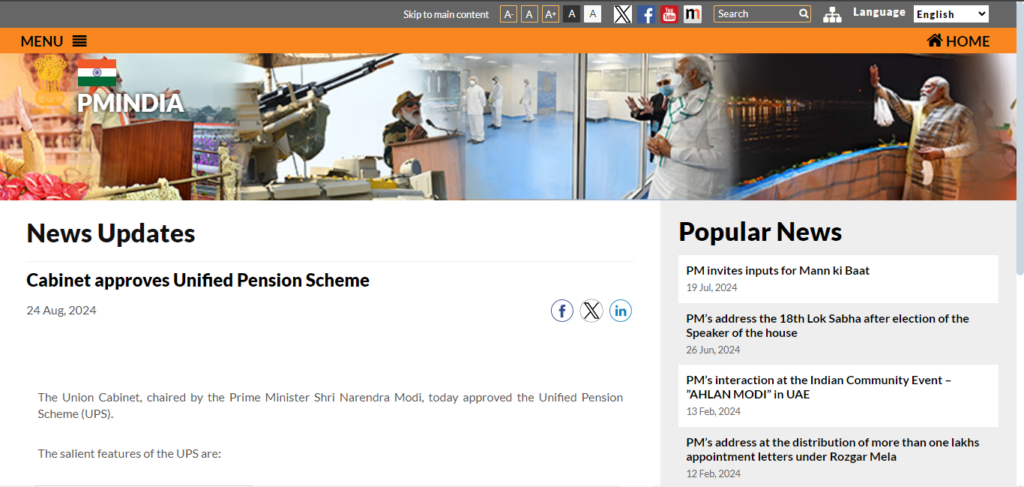Unified Pension Scheme: Key features, benefits, and FAQs

Unified Payment Scheme will be a gold mine for the central government employees, who joined the service in 2004. Employees, who have an account in the NPS (national pension scheme) can smoothly swift into the new UPS. The unified payment system was introduced in August 2024 (recently). This is a central government scheme for all the central government employees. UPS (unified pension scheme) will be effective in April 2025.
UPS offered a fixed pension amount, of over 50% of the pay (average) received by the employee over 12 months after 25 years of service. The contribution of the government has increased by 18.5%. The new scheme is an inflation-indexed and familial provision (receive the amount if the pensioner expires).
Now you must be thinking!
Why did the government introduce a new pension scheme and the difference between UPS and NPS or which will be better to opt for?
let’s find the answer so stay tuned!
The Unified Pension Scheme

The central government introduced the unified pension scheme on Saturday, August 2024. This scheme guarantees, that central government employees receive a continuous fixed pension after retirement. The new UPS will be implemented from 1st April 2025.
The Math of Pension in UPS
UPS guarantees a central employee receives more than 50% of the average amount. If the period of serving exceeds 25 years. The amount will be paid over the preceding 12 months. The UPS is a fixed pension scheme plus inflation-indexed. This scheme offers a familial provision if the pensioner dies under uncertain conditions.
It means if you work for more than 25 years you’ll be eligible to receive over 50% invested amount over the preceding 12 months. Plus there are several other benefits including inflation-indexed adjusted through the dear allowance.
Your Contribution Under UPS

The contribution rate of 10% of central government employees remains the same. Whereas! central government increases the contribution by 18.5% from 14%. Additionally, the union government allows a monthly payout of ₹10000 for those employees in the service for 10 years plus a lump sum retirement benefits.
The Difference Between UPS vs NPS
| Features | NPS | UPS |
| Risk | moderate risk due to market-linked incentives. | low risk due to government-backed and inflation-indexed. |
| Options for Investment | Equity, Debt, government securities (diverse) | Only Government securities. |
| The contribution rate from employee | 10% | 10% |
| Government Contribution | 14% | 18.5% |
| Pension guarantee | Depends | Yes about 50% of the average salary |
What will you Get in Retirement Under the Unified Payment Scheme?
You’ll receive a handsome lump sum amount with a multivitamin annulation plus gratuity. This means you will receive an amount of 1/10th of your monthly pay + dear allowance on the maturity period of 6 months superannuation on the fulfillment of service. However, this scheme is beyond any effect of this payment.
Minimus Pension Under UPS
- Under UPS those employees who completed the service of 25 years, the retired employee will receive the 50% of the average basic pay after the 12 months.
- Those employees who provide service for a shorter period of about 10 years will receive an initial amount of ₹10000 per month. This pension will be proportionate to your pay scale.
An Assumption Table for the Comparison of UPS and NPS
| Feature | UPS | NPS |
| lump sum amount | Yes | No |
| Min Monthly Payout | ₹10000 per month (for 10 years of service) | no |
| Government contribution | 18.5% | 14% |
| Employment contribution | 10% | 10% |
| Last salary | ₹1,36,595 | ₹1,36,595 |
| Corpus | ₹40 lk + | ₹35 lk + |
| Pension | ₹2,13,479 | ₹1,79,772 |
The Advantages of Unified Pension Scheme
- Under the UPS pensions listed in the inflation index.
- Family pension; The UPS provides an additional advantage of insurance. If an employee expires under an uncertain situation the spouse will receive about 60% of the pension.
- Dear Allowance; This scheme allows a permanent dear allowance proportionate to the salary.
- The scheme allows fixed lump sum payments in retirement.
Can you switch from UPS to NPS?

The provision for this is not applicable. You cannot switch back from UPS to NPS once you opted. The government only allowed for existing NPS/VRS and upcoming employees. However, the advantage under UPS is an increase in government contribution of 18.5% over the same employee’s 10% contribution. Additionally, there is a dear allowance + family insurance (60% of the employee’s salary) + a fixed lump sum of 50% of the average basic pay for employers over 25 years of service and ₹10000 per month (10 years of service).
Now the Question Which one is better?
Is UPS Worth to Go For?
According to NPS, a portion of the fund has to be invested in an annuity after retirement, Due to the low rate of annuity in India. a substantial corpus is required to achieve a fifty percent return on the investment. Additionally, according to the government, ninety-nine percent of employees or more will benefit from switching to the new pension policy.
Additionally, Under the UPS (Unified Pension Policy) the promised fifty percent is much safer from NPS.
Is UPS In Fashion?
UPS sustained the core values and principles of the defined contribution scheme. Moreover, UPS is upgraded with additional safety for employees with a minimum pension. Additionally, UPS addresses the demand of government employees for the promised pension.
What Are the Benefits of UPS?

- Higher contributions from the government – Under UPS( Unified Pension Plan) Governmental contribution is up to 18.5% compared to 14% under NPS. It is the major difference between UPS and NPS. Moreover, the boost is expected to provide better financial safeguards to employees after retirement. An increase in government contribution is the most significant point.
- Promised Pension – A Guaranteed pension of 50% for an average salary employee for over 12 years of service. The guarantee increases the credibility of UPS much more than NPS.
- Monthly Minimum Payout – UPS offers a monthly minimum payout of 10,000 rupees for employees with a minimum of 10 years of service. Additionally, the scheme (Unified Pension Scheme) provides a lump-sum amount of money at retirement. This makes UPS more credible than NPS.
Conclusion
With all the services and guarantees, UPS is much more credible and safer than NPS. Moreover, the higher contribution of the government is one of the most significant advantages for the employees, the guaranteed pension and monthly minimum payout the greater extent to provide lump-sum money at retirement, making UPS dependent and financially safe and sound for the employees post-retirement.
